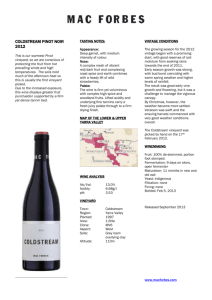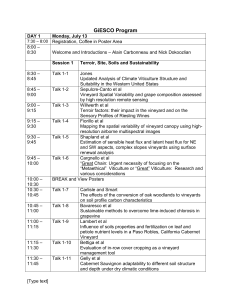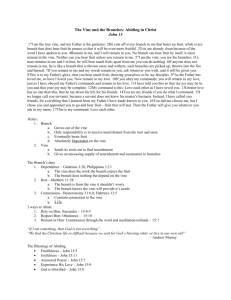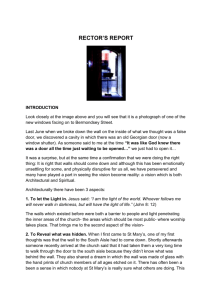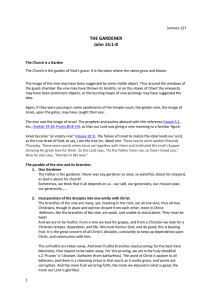Document 11941871
advertisement
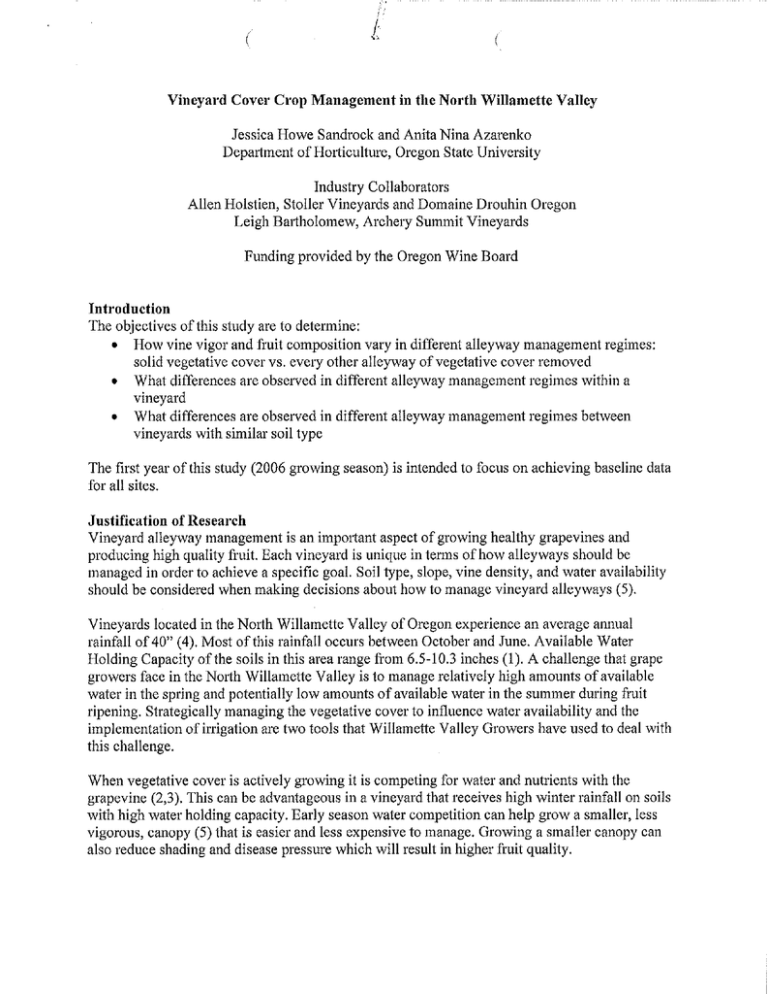
( Vineyard Cover Crop Management in the North Willamette Valley Jessica Howe Sandrock and Anita Nina Azarenko Depm1ment of Hm1iculture, Oregon State University Industry Collaborators Allen Holstien, Stoller Vineyards and Domaine Drouhin Oregon Leigh Bm1holomew, Archery Summit Vineyards Funding provided by the Oregon Wine Board Introduction The objectives of this study are to determine: o How vine vigor and fmit composition vary in different alleyway management regimes: solid vegetative cover vs. every other alleyway of vegetative cover removed o What differences are observed in different alleyway management regimes within a vineyard o What differences are observed in different alleyway management regimes between vineyards with similar soil type The first year of this study (2006 growing season) is intended to focus on achieving baseline data for all sites. Justification of Research Vineyard alleyway management is an impot1ant aspect of growing healthy grapevines and producing high quality fruit. Each vineyard is unique in terms of how alleyways should be managed in order to achieve a specific goal. Soil type, slope, vine density, and water availability should be considered when making decisions about how to manage vineyard alleyways (5). Vineyards located in the Nmih Willamette Valley of Oregon experience an average annual rainfall of 40" (4). Most of this rainfall occurs between October and June. Available Water Holding Capacity of the soils in this area range from 6.5-10.3 inches (1 ). A challenge that grape growers face in the Nm1h Willamette Valley is to manage relatively high amounts of available water in the spring and potentially low amounts of available water in the summer during fruit ripening. Strategically managing the vegetative cover to influence water availability and the implementation of irrigation are two tools that Willamette Valley Growers have used to deal with this challenge. When vegetative cover is actively growing it is competing for water and nutrients with the grapevine (2,3). This can be advantageous in a vineyard that receives high winter rainfall on soils with high water holding capacity. Early season water competition can help grow a smaller, less vigorous, canopy (5) that is easier and less expensive to manage. Growing a smaller canopy can also reduce shading and disease pressure which will result in higher fmit quality. If a grower's goal is to reduce water and nutrient competition, vegetative cover can be removed in early spring. Typically this has been done by tilling the cover in when soil conditions and equipment availability allow. Tilling the cover in will reduce competition while adding biomass to the soil (2,5). The thought being that nitrogen is being put back into the vineyard system for the vine to use later (3). It is known that grapevines use plant nitrogen reserves for growth from bud break until bloom. Grapevines stm1 to use soil available nitrogen when 5-7 leaves have expanded until fruit set. The maximum amount of soil available nitrogen uptake occurs at fruit set. After fruit set the use of soil available nitrogen declines and redistribution of nitrogen that has accumulated in the vine canopy is used during stage three offruit ripening. Translocation of nitrogen from the canopy continues until leaf senescence. There is a brief period after harvest and prior to leaf senescence that soil available nitrogen can be taken up if conditions allow (6). Managing alleyways to manipulate vine growth and physiology is a matter of timing and intensity. It is the goal of this study to consider the degree to which competition from vegetative cover is beneficial in commercial vineyards in the North Willamette Valley and eventually consider the best times to impose or remove competition. Materials and Methods Experimental Design This experiment is being conducted in three commercial vineyards located in the North Willamette Valley: Stoller Vineyard, Archery Summit, and Domaine Drouhin Oregon (DDO). Table 1 describes site details for all three vineyards. ( ( Vineyard Details Table I· Site details for Stoller Vineyard Archery Summit Vineyard and DDO ' ' Stoller Archery Summit DDO alternate row removal alternate row removal alternate row removal Treatment of cover crop (EO) vs. of cover crop (EO) vs. of cover crop (EO) vs. comparisons solid cover crop (S) solid cover crop (S) solid cover crop (S) vs. complete cover crop removal (CR) Treatment Complete randomized Complete randomized Complete randomized organization block design block design block design Treatment Replicated five times Replicated five times Replicated three times replication on groups of 16 vines on groups of24 vines on groups of 16 vines Perennial blend Cover crop Mix of reemerging Perennial grass plus composition red fescue (seeded (Bailey Seed Pathway volunteer species 2002) and Kentucky Blend)of 60% Elf (seeded fall 2005) bluegrass (seeded perennial rye grass, Sept. 2005) 20% creeping red fescue, 20% hard fescue (seeded winter 2006 in clean cultivated rows from 2005) Cover removed for April 19, 2006 April 19,2006 May 81", 2006 Alternate (EO) and Complete (CR) treatments spaded tilled How cover was tilled removed no no yes Irrigation Pommard/Riparia 667/101-14 Pommard/3309 Plant material 1996 1989 Year planted 1999 1 April 26'", 2006 April 19, 2006 April15 \ 2006 Budbreal< Parameters of Interest Vegetative vigor- Pruning weights were collected per vine on December i\ 2006 at Stoller and DDO. Pruning weights were determined by weighing all of the one-year old wood per vine. Shoot count- The number of shoots per vine were determined post-harvest at Stoller and DDO. Ripening dynamics- Brix, pH, and T A were monitored during ripening. Sampling began at the onset ofveraison and occurred on a weekly basis until harvest. 5 clusters per replicate were collected in the morning and processed immediately. Soluble solids (brix) ofjuice samples were determined using a hand held refractometer. pH ofjuice samples ( was determined using a Scholar 425 pH meter and Sentix 62 electrode. Titratable acidity was determined using the titrametric procedure using NaOH as described by Zoecklein et a! (7). Fruit composition at harvest- Each treatment replicate was harvested separately. 25 clusters per replicate were collected in the morning and processed immediately. Must samples were delivered to ETS Laboratories (McMinnville) for analysis. Basic juice profile was determined using ETS Laboratories methods for brix, pH, titratable acidiy, L­ malic acid, tartaric acid, potassium, glucose and fi·uctose, alpha-amino compounds, and ammonia. The affects of cover crop management on vine vigor and fruit composition were analyzed using the ANOV A procedure and subjected to the t-test. All statistics were performed using the SAS System version 9 statistical package. Results The experimental block at Archery Summit was lost following fruit set. Therefore, no results were obtained fi·om that site. Fruit from the DDO site was lost at harvest. Therefore, fruit composition at harvest was not evaluated. Stoller Ripening dynamics -No treatment differences were observed in juice soluble solids, pH, or titratable acidity (TA) during ripening or at harvest (Figure !a, Figure 1b, and Figure !c). The alternate row (EO) treatment tended to have higher brix during the last three weeks of ripening (Figure !a). The increase in brix, for both treatments, between September 20'" and harvest (September 29'") may be due to precipitation that occurred during this week followed by high temperatures. Beny dehydration may have occurred. A similar increase in pH was observed in both treatments (Figure 1b). Fruit composition at harvest- Malic acid and alpha-amino compounds were significantly higher in the solid cover treatment (S) at harvest (Table 2). The literature suggests that reducing vegetative competition may enable vines to translocate nitrogen stored in the canopy to the fruit during ripening (3). These results do not supp01i that theory. This suggests that the solid cover treatment did not have a negative affect on nitrogen accumulation in the fruit prior to harvest. This may be due to the fact that this vineyard site is irrigated and vines were able to continue translocation regardless of vegetative competition. Vine vigor- Table 3 and Table 4 illustrate vine vigor in 2005 and 2006 respectively. Pmning weights decreased in both treatments in 2006 (Table 4). There was a greater decrease in vigor in the solid cover treatment (S) between 2005 and 2006. This suggests that regardless of this site being irrigated these vines may have undergone greater competition for resources than the alternate row treatment (EO). ( DDO Ripening dynamics - On one date during ripening (Figure 2a) the solid cover treatment (S) had significantly higher brix than the alternate row (EO) or complete removal treatment (CR). On the final sampling date prior to harvest, no treatment differences in brix were observed. Treatment differences in titratable acidity were observed on September 61h and September l3 1h (Figure 2c) with the alternate row treatment (EO) having higher TA on both dates. The complete removal treatment (CR) also had higher TA than the solid cover treatment (S) on September 13 1h. No treatment differences were observed in pH (Figure 2b). Vine vigor- Table 5 and Table 6 illustrate vine vigor in 2005 and 2006 respectively. No treatment differences were observed and vigor tended to decrease in all treatments between 2005 and 2006. Summary and Future Wo1·k Results from the first year of this study suggest that manipulating vegetative competition in the alleyway can manipulate vine vigor and the vines ability to translocate material from the canopy to the fruit during ripening. However, imposed vegetative competition can possibly be overcome by irrigation. Future work on this project will seek to improve experimental design by adding a complete cover removal treatment to serve as a control at all three sites. Additional canopy density data will be evaluated during the growing season. Collaborators and other industry patiicipants have also determined that additional fruit and wine composition parameters need to be evaluated. Specifically, aroma and flavor precursors in the fruit and wine will be evaluated. Future collaboration with The Department of Food Science and Technology, OSU, will address these new research questions in 2007. Figure 1: Juice soluble solids (a), pH (b), and titratable acidity (c) of juice during ripening and at harvest at Stoller Vineyard (2006). *,**,and*** indicate statistically significant at the 0.05, 0.01, and 0.001levels of probability, respectively. ( Figure 2: Juice soluble solids (a), pH (b), and titratable acidity (c) of juice during ripening at DDO Vineyard (2006). *,**,and*** indicate statistically significant at the 0.05, 0.01, and O.OOllevels of probability, respectively. -+-Sofid (S) ----Alternate Cover (EO) __,_Complete Removal (CR) 24 * w :2 0 "'.c-" 20 "'• ..," 18 0" .~ 16 ''';/L ~ . ,: 14 24-Aug 31-Aug 14-Sep 21-Sep --~-·- -·-----,1 b3.30 --+-So!id(S) --Alternate Cover (EO) -~<--Complete Removal (CR) 3.25 3.20 3.15 3.10 :I: Q, • ..,"'" 3.05 3.00 2.95 2.90 2.80 +-----~---~----~----,.--" 24-Aug 31-Aug 7-Sep c 16-,---­ -+--Sofld(S) ---Alternate Cover (EO) --Complete Removal (CR) 6 4+----~----,-----~---~ 24-Aug 31-Aug 14-Sep 21-Sep Table 2 · Basic juice profile means of Stoller Vineyard at Harvest (September 29 , 2006) Solid Cover Alternate Cover Significance (S) (pvalue) (EO) brix (0 ) 26.1 25.9 ns (0.6817) pH 3.43 3.38 ns (0.0618) titratable acidity 0.61 0.57 ns (g/100ml) (0.2461) potassium (mg/L) 1022 964 L-malic acid (g/L) 3.06 2.40 tartaric acid (g/L) 4.52 4.81 glucose + fructose (g/100ml) 28.76 28.34 alpha-amino compounds (mg/L) 232.20 190.00 ammonia (mg/L) ns (0.1717) * (0.0470) ns (0.0601) ns (0.4992) * (0.0348) 180.0 ns (0.1260) .. . . ' ' md1cate ns, ~, n, and ~n not s1gmficant, and statistically s1gmficant at the 0.05, 0.01, and 0.001 levels of probability, respectively. Table 3: Vine vigor at Stoller Vineyard (2005) Solid Cover (S) 2.27 pruning weight (i<g/vine) 21 shoots per vine pruning weight per shoot (g) .. ... I 07.39 159.6 Alternate Cover (EO) 2.33 21 112.19 Significance (pvalue) ns (0.7039) ns (0.7632) ns (0.4343) ns, ~, n , and h~ md1cate not s1gmficant, and statistically s1gmficant at the 0.05, 0.01, and 0.001 levels of probability, respectively. Table 4· Vine vigor at Stoller Vineyard (2006) Solid Cover (S) 1.47 pruning weight (kg/vine) 20 shoots per vine pruning weight per shoot (g) Alternate Cover (EO) 1.76 Significance (pvalue) * (0.0415) ns (0.5684) ns (0.0956) 20 73.66 86.35 ''' . ns, ~,""",and~""" md1cate not s1gmficant, and statistically s1gmficant at the 0.05, 0.01, and 0.001 levels of probability, respectively. 0 0 Table 5· Vine vigor at DDO Vineyard (2005) Alternate Cover Solid Cover (S) (EO) 0.61 0.60 pruning weight (kg/vine) 9 9 shoots per vine 68.03 pruning weight per shoot (g) 69.35 Complete Removal (CR) 0.59 9 65.30 Significance (pvalue) ns (0.7865) ns (0.0775) ns (0.3795) ns, "',"'*,and •~• md1cate not s1gmficant, and statistically s1gmficant at the 0.05, 0.01, and 0.001 levels of probability, respectively. Table 6· Vine vigor at DDO Vineyard (2006) Solid Cover Alternate Cover (S) (EO) 0.58 0.60 pruning weight (kg/vin~) 10 10 shoots per vine 61.96 pruning weight per shoot (g) 59.92 Complete Removal (CR) 0.59 10 60.88 Significance (pvalue) ns (0.7651) ns (0.5062) ns (0.8952) ns, "',""",and ~•• mdJCate not s1gmficant, and statlstJCal!y s1gmficant at the 0.05, 0.01, and 0.001 levels of probability, respectively. 0 0 0 0 Acknowledgements Financial support for this project provided by the Oregon Wine Board is greatly appreciated as is the technical support from ETS laboratories and the collaboration and commitment from Stoller Vineyard, Domaine Drouhin Oregon, and Archery Summit Vineyard. References Cited 1. Campbell, A. and D. Fey (2003). Soil Management and Grapevine Nutrition. In E.W. Hellman (Ed). Oregon Viticulture (pp. 145). Corvallis, OR: Oregon State University Press. 2. Lanyon, D.M., A. Cass, and D. Hansen (2004). The effect of soil properties on vine performance. CSIRO Land and Water Technical Repm1 No. 34/04. 3. Rupp, D. (1996). Green cover management to optimize the nitrogen supply of grapevines. Proc.Workshop Strategies to Optimize Wine Grape Quality. Acta Hort. 427:57-62. 4. Western Regional Climate Center. http://www.wrcc.dri.edu/pcpn/or.gif 5. William R.D. and D. Crisp (2003) Floor Management. In E.W. Hellman (Ed). Oregon Viticulture (pp. 167-171). Corvallis, OR: Oregon State University Press. 6. Winkler, A.J., J.A. Cook, W.M. Kliewer, and L.A. Lider (1962). General Viticulture (2 11d Ed). CA: University of California Press. 7. Zoecklein B.W., K.C. Fugelsang, B.H. Gump, and F.S. Nury (1999). Wine Analysis and Production (pp. 511 ). Gaithersburg, Maryland: Aspen Publication.

